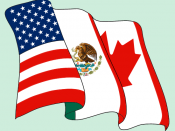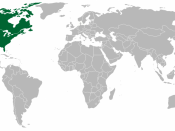The purpose of this report is to help employees understand the economic experience of Mexico since The North American Free Trade Agreement (NAFTA). Specifically, it looks at the at trade liberalization, national sovereignty, relationship with the World Bank and International Monetary Fund (IMF), World Trade Organization (WTO) and committees, workers rights, and types of economic development. There is a lot of controversy when it comes to NAFTA and whether it has helped or hurt Mexico. Controversy has been especially high in the aspect of agriculture trade.
NAFTA is a trade agreement between the U.S., Canada, and Mexico that went into effect January 1, 1994. NAFTA has opened previously protected sectors in agriculture, energy, textile, and automotive. It opened up the U.S.-Mexico border to trade in services i.e. telecommunications. It has established rules on government procurement and intellectual property rights. These are just a few of the changes that NAFTA implemented.
"Trade liberalization is the reduction of tariffs and removal or relaxation of nontariff barriers to trade (NTBs)" (Deodroff, 2001). NAFTA has eliminated many tariffs immediately while others will be phased out over a period of 5 to 15 years. NTBs affecting agriculture trade between the U.S. and Mexico were eliminated immediately. Tariffs affecting trade in dairy, eggs, poultry, and sugar are maintained. Agriculture in Mexico has a higher impact in the Mexican economy than the U.S. agriculture has on the U.S. economy. "Agriculture contributes to 8 percent to Mexico's gross domestic product (GDP) and employs about 22 percent of the labor force. For the United States, agriculture comprises only 2 percent of GDP and employs about 2.7 percent of the labor force" (Harrington, 1999).
Mexico has given up some of its national sovereignty for economic growth and help. Most of the national sovereignty they have given up has been...


